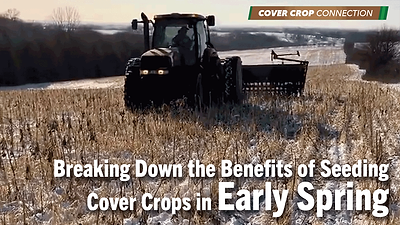Every year we learn more about the soil saving and water quality protecting benefits of cover crops. A cover crop (in our area, primarily cereal rye) protects the soil surface from erosion. In addition, the cover crop’s living root in the soil throughout winter helps to salvage excess nutrients before they reach surface waters. The roots also help to stimulate and increase soil microorganisms that extract nutrients from crop residue and soil minerals. The end result is a protected soil that requires less inputs to produce the same crop. In addition, the soil can absorb and retain much more water. To make cover crops work, next year’s crop is planted without tillage to enhance the soil’s biologic activity.
Several thousand acres in our area had cover crops aerially seeded in early September and these acres are now identifiable due to the beautiful green color of the rye. Many more acres were seeded following harvest this past month; this rye is just emerging now. As long as there is slight growth before the ground freezes solid, the rye roots will grow into the soil profile all winter, improving the soil and profitability of the land. When traveling, look for these fields and the operators who believe in this practice. These persons realize that the soil remaining is a valuable living resource and not just something that keeps crops vertical.
Iowans have lost half of their topsoil in the past 130 years; what remains requires more artificial inputs each year to grow a crop. Helping producers understand that tillage is not a good idea for them and for the quality of the community’s natural resources has proven difficult. As more landowners become proactive in the management of their remaining soil by requiring producers to make changes, including cover crops, topsoil will be preserved and enhanced.
Change will be necessitated in the near future by the market. Consumers are beginning to demand that their food, fiber, and fuels be grown in a responsible manner. Every year more federal, state, and even local funding through watershed groups is dedicated to promoting the use of cover crops through cost-share paid to the producer. Still, according to the eight year-old Iowa Nutrient Reduction Strategy, Iowa needs at least twelve million acres of cover crops to achieve only a 45% reduction in nitrogen and phosphorus run-off into the Gulf of Mexico. This past year the state is still short of one million acres.
Farmers are by nature independent, and many believe that what they do on their own property has no effect on others. If there was a way to guarantee that no dissolved soil, no windblown soil, no pesticides, no plant nutrients, and no water ever left your farm, then landowners and producers could continue with their traditional farming practices . However, we are all in this together and the quality of neighboring and downstream resources should be important to everyone.



